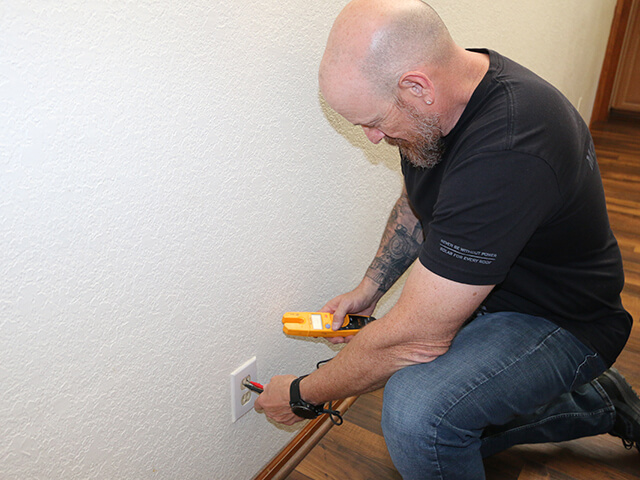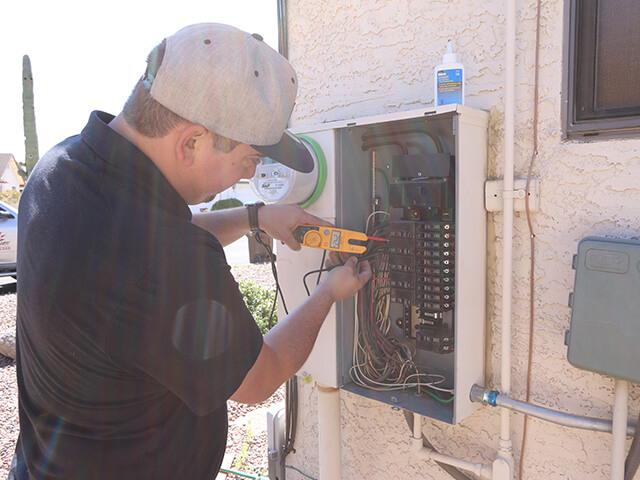Energy-Efficient Lighting Solutions for Your Home
One of the simplest yet most effective ways to enhance energy efficiency is through lighting solutions. With advancements in technology, numerous lighting options now not only reduce your energy consumption but also lower your electricity bills.
Because of this, the expertise of a residential electrician becomes invaluable for implementing these solutions in a safe, effective manner.
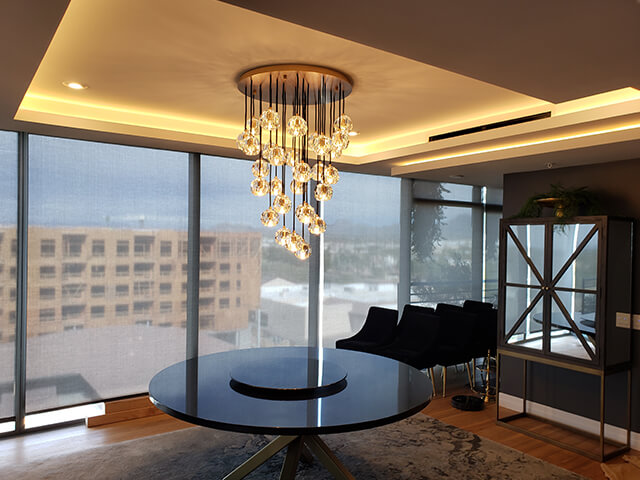
LED Lighting – The Efficient Frontier
LED lighting represents a significant leap forward in home energy efficiency. These bulbs are not just energy savers; they bring a long lifespan and versatility to the table. With their ability to use substantially less energy compared to traditional incandescent bulbs, LEDs are an excellent choice for both environmental and economic benefits. They fit seamlessly into various home settings, offering a range of types and styles to suit any room.
- Comparison of LED lights with traditional incandescent bulbs: LEDs use about 75% less energy and last 25 times longer.
- Types of LED lighting for home use: Options include standard bulbs, recessed lights, and smart LED lights.
- Cost and energy savings comparison:
| Type of Bulb | Energy Usage | Lifespan |
| LED | Low | Very High |
| Incandescent | High | Low |
Smart Lighting Systems
Smart lighting systems are revolutionizing the way we illuminate our homes, offering a blend of convenience, aesthetics, and energy efficiency. These advanced systems enable remote control and automation of home lighting, allowing homeowners to manage and customize their lighting preferences with ease.
Beyond just the convenience factor, smart lighting is an integral part of a holistic home automation strategy, contributing significantly to reducing overall energy consumption. Moreover, the expertise of a residential electrician is pivotal in professionally installing and seamlessly integrating these systems into your home’s existing electrical framework, ensuring both functionality and safety.
- Smart lighting systems explained: They allow remote control and automation of lighting, enhancing energy efficiency.
- Benefits with home automation: Integration with other smart home devices for optimal energy usage.
- Residential electrician’s role: Professional installation and integration into existing electrical systems.
Utilizing Natural Light
Harnessing the power of natural light in your home isn’t just about creating a warm and inviting atmosphere; it’s also a key strategy in reducing your reliance on artificial lighting, thereby enhancing energy efficiency. By thoughtfully incorporating elements that maximize natural light, you can illuminate your home more naturally and decrease your energy consumption. Here are some creative ways to bring more sunlight into your living spaces, which can lead to significant savings on your energy bills while fostering a healthier and more pleasant home environment.
- Strategies for maximizing natural light: Use of mirrors, light-colored walls, and strategic window placement.
- Impact on artificial lighting needs: Reduces dependency, thus lowering energy consumption.
- Window treatment tips: Sheer curtains and skylights to enhance natural light.
Energy-Efficient Lighting Fixtures
- Overview of energy-efficient fixtures: Focus on Energy Star-rated fixtures for the best efficiency.
- Choosing the right fixtures: Considerations for different home areas – kitchens, living rooms, bedrooms.
- Energy consumption comparison:
| Fixture Type | Energy Efficiency |
| Energy Star-rated | High |
| Non-rated standard | Low |
Dimmer Switches and Controls
Dimmer switches and controls in your home lighting system is not only a step towards personalized ambiance but also a smart approach to energy efficiency. By allowing you to adjust the intensity of your lights, dimmers can significantly reduce your home’s electricity consumption and extend the life of your bulbs. It’s important to note the necessity of professional installation by a residential electrician to ensure safety and optimal functionality of these controls.
- Energy reduction through dimmers: Adjusting light levels to save energy.
- Types of dimmers: Slide, rotary, smart dimmers.
- Safety and installation: Importance of professional installation by a residential electrician.
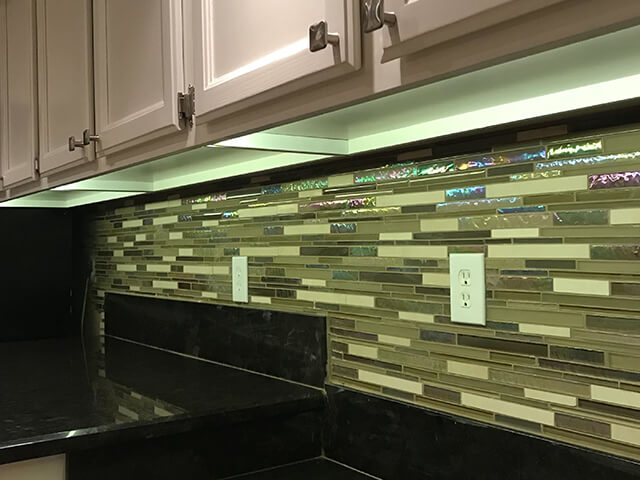
Motion Sensor Lights for Efficiency
Motion sensor lights are an excellent solution for enhancing energy efficiency in your home. These lights are ideal for hallways, garages, and outdoor spaces, where they can contribute significantly to energy savings by automatically turning off when not needed, reducing waste. With optimal placement and sensitivity settings, motion sensor lights can be a valuable addition to your home’s lighting system.
| Benefits in select home areas | Contribution to energy savings | Installation best practices |
| Ideal for hallways, garages, and outdoor spaces | Lights turn off automatically when not needed, reducing waste | Optimal placement and sensitivity settings |
Solar-Powered Outdoor Lighting
If you are looking for a way to illuminate your outdoor space without adding to your electricity bill, solar-powered outdoor lighting might be the perfect solution.
Solar lights use the sun’s energy to charge during the day and automatically turn on at night. They come in various shapes, sizes, and styles to suit your needs and preferences. In this section, we will discuss some of the advantages of solar lights, the types of solar lighting available, and some tips to make them more efficient.
Advantages of Solar Lights
Solar lights help save money because they use sunlight for power, which is free. They are good for the environment because they don’t use electricity generated from power plants, which ultimately reduces pollution. Solar lights are also easy to put up because they don’t need wires or to be plugged in. You can place them anywhere that gets sunlight.
Types of Solar Lighting Available
You can find many kinds of solar lights to fit what you need. Path lights are small posts with a light on top that go along walkways to show the way. Spotlights are stronger lights that focus on a specific spot, like on a flag or a garden feature. There are also decorative solar lights that look pretty and light up your yard or patio.
Tips to Make Solar Lights More Efficient
To get the most out of your solar lights, put them in places where they get a lot of sun during the day. Make sure nothing like leaves or dirt is blocking the solar panel on top of the light. Cleaning the panels regularly will also help them charge better and keep your lights bright at night.
Color Temperature and Energy Efficiency
LED lights with different color temperatures can affect energy efficiency, ambiance, and productivity. Lower color temperatures (e.g., 2700K) produce a warm, yellowish light, resembling candlelight, while higher color temperatures (e.g., 5000K) produce a cool, bluish-white light, similar to daylight. LED lights with adjustable color temperatures offer flexibility and are energy-efficient.
To measure and adjust the color temperature of LED lights, you can use the Kelvin (K) scale, which ranges from warm to cool tones. For example, 2700K is warm white, similar to incandescent bulbs, while 5000K is daylight, ideal for outdoor or commercial spaces. Some LED lights are designed to toggle between different color temperatures, providing versatility for various tasks and settings.
The best color temperatures for different spaces are as follows:
| Light Type | Temperature | Best for | Effect |
| Warm Light | 2700K-3500K | bedrooms, living rooms, dining areas | Cozy atmosphere |
| Neutral Light | 3500K-4500K | kitchens, workspaces | Balance between warm and cool lighting |
| Cool Light | 4500K-5000K | offices, task-oriented areas | Bright and focused illumination |
Task Lighting Versus Ambient Lighting
Task lighting serves a crucial role in providing focused illumination for activities such as reading, cooking, or working. This lighting type is brighter than ambient lighting, enabling clear visibility of details which is essential for tasks requiring precision. Common implementations of task lighting include desk lamps, under-cabinet lights, and vanity lights, which are typically adjustable to direct the light precisely where needed. The cooler color temperature range of 3500K to 5000K is often selected for task lighting to promote concentration and reduce eye fatigue.
On the other hand, ambient lighting is key to establishing the overall illumination and atmosphere of a space. It provides a base level of light, ensuring visibility and contributing to the room’s overall comfort and aesthetic. Ambient lighting is generally softer and less intense than task lighting and is distributed evenly across the room to avoid creating harsh shadows. Typical sources include overhead fixtures such as chandeliers, ceiling lights, recessed lights, as well as wall sconces and floor lamps. The color temperature for ambient lighting can vary, with warm tones (2700K-3000K) creating a relaxing environment, neutral tones (3500K-4000K) for balanced everyday lighting, and cooler tones (4500K and above) for a more alert atmosphere.
In effective lighting design, the integration of both ambient and task lighting is essential. Ambient lighting establishes the base level of light for general visibility and comfort, while task lighting provides focused light where needed for specific activities. This combination ensures a functional, well-lit space that is conducive to various activities and enhances the overall environment.
| Lighting Type | Purpose | Intensity | Direction/Distribution | Placement | Color Temperature |
| Task Lighting | Designed to provide focused illumination for specific activities | Brighter than ambient lighting | Focused on the work area | Adjustable sources | Cooler (3500K-5000K) |
| Ambient Lighting | Provides overall, comfortable illumination for an entire space | Softer, less intense than task lighting | Evenly spread across the room | Overhead fixtures | Varies depending on the desired mood |
Key takeaway: Most rooms ideally benefit from a combination of ambient and task lighting. Ambient lighting lays the foundation, while task lighting provides focused light for when you need to accomplish specific activities.
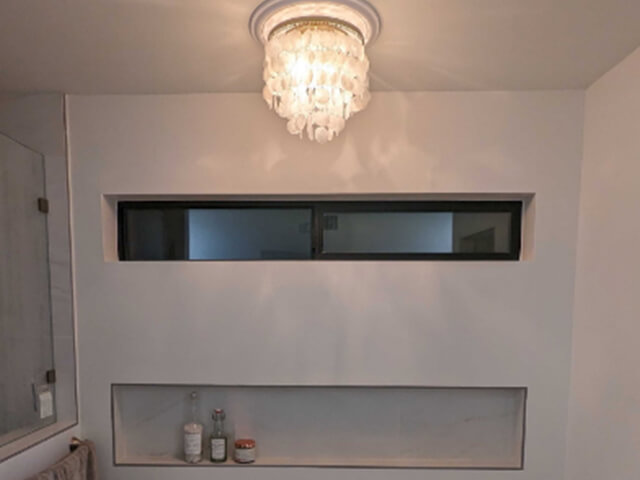
Regular Maintenance and Upgrades
Maintaining your lighting system is crucial for several reasons. Regular checkups catch potential safety hazards such as loose wires or cracked sockets, keeping your home or business protected from electrical fires. By cleaning fixtures and checking electrical connections, you’ll ensure your lights aren’t unnecessarily wasting energy. Plus, replacing bulbs proactively instead of waiting for them to burn out and cleaning reflective surfaces maximizes the lifespan of your fixtures and bulbs. All of this translates into a well-lit environment that provides consistent light output and the desired color temperature.
When is an Upgrade the Right Choice?
There are many telltale signs that your lighting system is ready for a more significant upgrade. Outdated technology, especially old incandescent bulbs or less efficient fluorescent systems, can send your energy costs soaring.
Switching to modern LED systems often results in a noticeable reduction in your utility bills. Constant bulb replacements become both tedious and costly; updating fixtures and using LEDs will reduce the frequency of those changes. Inconsistent light quality, such as flickering, dimming, or variations in color between bulbs, indicates a system that needs to be improved for more balanced, comfortable light output. Obviously, if you’re wanting to integrate smart home technology, you will need to update your lighting to allow for remote control and energy-saving automation.
Electricians: Experts in Lighting Upgrades
For the safest and most effective lighting upgrades, calling in a licensed electrician is the smart choice. Their expert understanding of your electrical system enables them to tailor recommendations for lights that make sense for your specific layout, goals, and budget. An electrician ensures that safety standards are met, reducing the risk of faulty installations that could be hazardous.
Furthermore, their knowledge allows for custom light selection based on the function of each room, color temperatures to fit the mood, and the inclusion of controls that fit your desired level of convenience.
Contact Redline Electric and Solar today
Adopting energy-efficient lighting is a smart move for any homeowner looking to reduce energy bills and contribute to a healthier environment. The array of options available today offers something for every need and preference. However, to ensure these systems are installed and maintained correctly, the assistance of a qualified residential electrician is crucial.
Start planning your lighting upgrades today, and take a step towards a more energy-efficient, brighter future for your home. Contact Redline Electric and Solar for professional advice and installation services.


